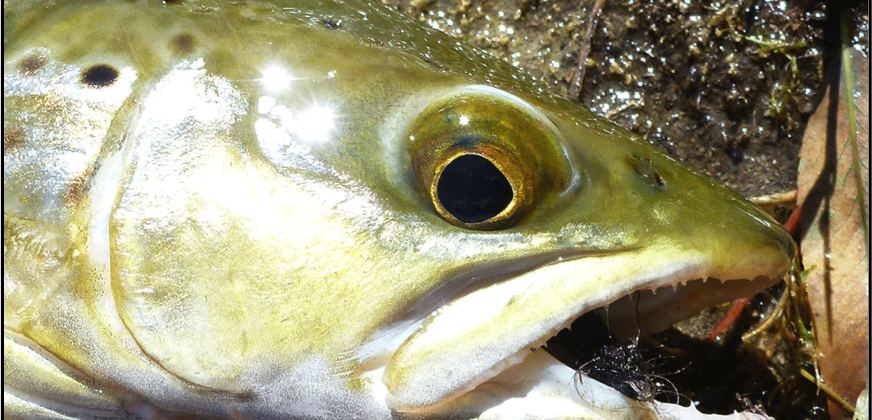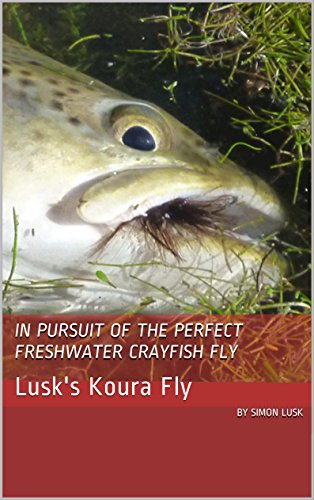Lusk’s Koura VII

A Fish Catching Fly
This series of articles is available as an ebook on Amazon.
Having finally got a design that was easy to cast and easy to present to fish I when back to test patterns #6 & 7 on in Lake Tutira. The browns were cruising the edge of the lake as expected, though not in great numbers.
The first fish I cast to did not get a good cast. The fly landed about 8m away from the fish, but not in a straight line, it was off on an angle of about 45 degrees. Rather than pull the fly out of the water and risk spooking the fish I left it in and gave it a twitch when the fish was about 5m away, but still very much angling away from the fly.
The response I got was the most aggressive I have ever seen for a sub surface fly. The fish turned and charged the Koura fly. It was an exceptionally aggressive response, and the fish hooked itself.
Conditions were only average at Tutira, with a slight wind and the start of an algae bloom, so I only saw five fish in a mornings fishing. The second fish, a good brown, charged the fly, refused, turned, refused, then took and my leader parted at a join between the 5lb & 6lb.
Further around the lake edge I spotted a nice brown of about 5lb cruising a big sandy bay. I got a long way ahead of him and got the fly down. When he got to about 4m away he was going well outside the fly, so I gave it a twitch and he charged it. He was coming straight for the fly and I saw his mouth open and close over the fly and I stripped striked. This pulled the fly out of his mouth, and forward about a metre. He charged it again and took again and I pulled the fly out of his mouth again.
These fish exhibited the kind of behaviour I expected from a cruising lake brown. They saw a high energy potential food source and chased it aggressively. They moved further than I expected, suggesting that Koura are a prime food source. The only other fly I have seen fish move so aggressively for is a cicada, another high energy potential fly that fish attack hard.
Presenting the Koura Fly in Lakes
The key to presenting the Koura fly is getting the fly too the bottom before the fish sees it. Koura do not sit in mid water. They are on the bottom, or desperately attempting to get to the bottom. Browns are unlikely to come up in the water column to take a subsurface fly as their food sources are not suspended mid water.
It is crucial to get far enough in front of the fish so it does not see the fly sinking. This can require several casts as the fish will often change directions before reaching the fly. It is better to make a poor cast and start again than to cast too close to a cruising fish and have it see the fly hit the water and sink.
The most surprising thing about the Koura fly tied with mohair yarn is that even with a 3.5mm tungsten bead it would still float on the surface due to the air trapped in it. This is a fly that needs a little sinkant or to be put in the water and have the air squeezed out of it.
Presenting the Koura Fly in Rivers & Streams
I fish a number of small streams with slow currents and big pools. The trout cruise the pools foraging, and are usually feeding near the bottom. These streams are full of wary Koura and are a high energy potential food source for trout.
While these pools are relatively slow moving they have enough water flow to mean a bulky but light fly will not get to the bottom quickly. The 3mm tungsten bead was not enough weight to work in my favourite small stream, but the 3.5mm bead had enough weight to get down to the bottom quickly and stay there.
Provided the fly was near or at the bottom when the fish spotted it there was an exceptionally aggressive response. Fish charged the fly, and hit it hard. If they did not see the fly a short strip and letting the fly sink again always attracted attention.
Koura are such high energy potential food sources that I found even disturbed fish would take it. Slightly spooked or wary rainbows would not be able to resist a koura fly. The fish’s caution seemed to be overcome by the large meal near them, so even though I was sure they were on to me they still took.
Retrieving the Koura Fly
The best response to the Koura fly comes with a retrieve that is realistic. My initial retrieve when I think the fish should be able to see the fish is a short twitch of a few inches. This gives the fly enough action to make it look alive and to attract the attention of the fish.
If the fish turns and charges the fly I do not move it again, and either let the fish take the fly and set the hook itself or use a strip strike. A really aggressive take means that an aggressive strike can result in break offs. If the fish takes but does not hook up the strip strike keeps the fly in the water and close to the fish so it may take it a second time.
The other important lesson I learned fishing the koura fly is that moving the fly with the rod tip rather than a hand strip does not work. Even the gentlest of twitches of the rod tip will result in the fly moving far too far. The energy created by the rod tip movement moves the fly far further than the movement of the rod tip itself.
I. Lusk’s Koura | II. Further Design Work | III. Trout & Flies for Similar Conditions | IV. Design Features for the Next Prototype | V. Rethinking the Koura Pattern | VI. Prototype 3, 4 & 5 | VII. A Fish Catching Fly | VIII. Further Design Work II | IX. Lusk’s Koura Tying Instructions | X. Fishing Lusk’s Koura | XI. The Best Pattern

This series of articles is available as an ebook on Amazon.
